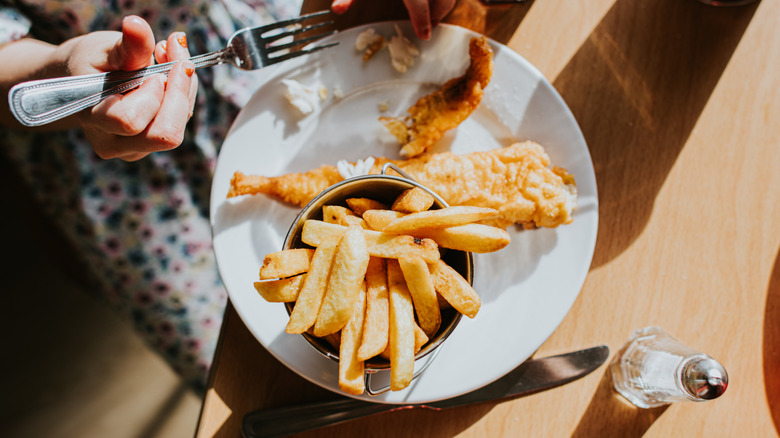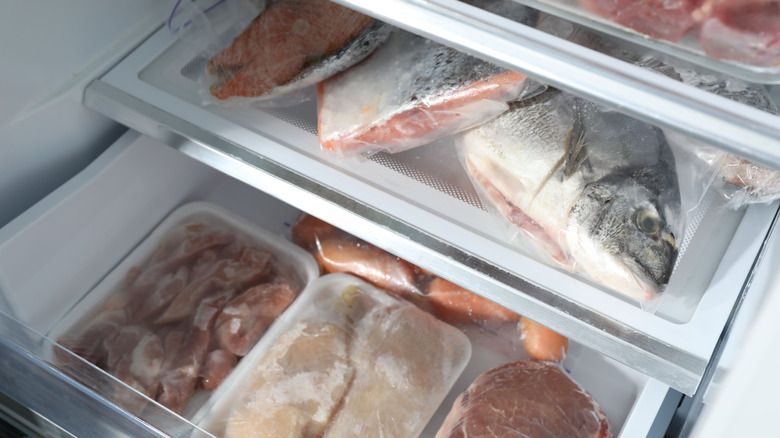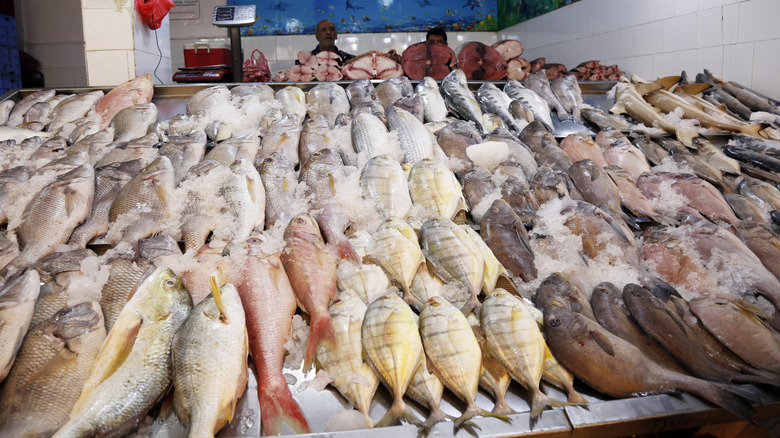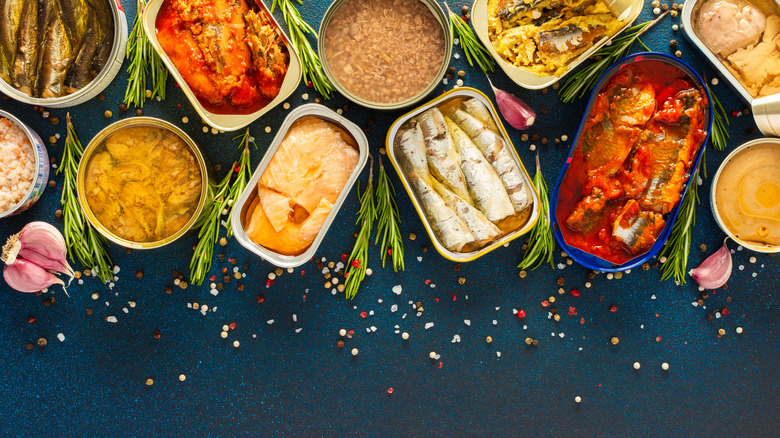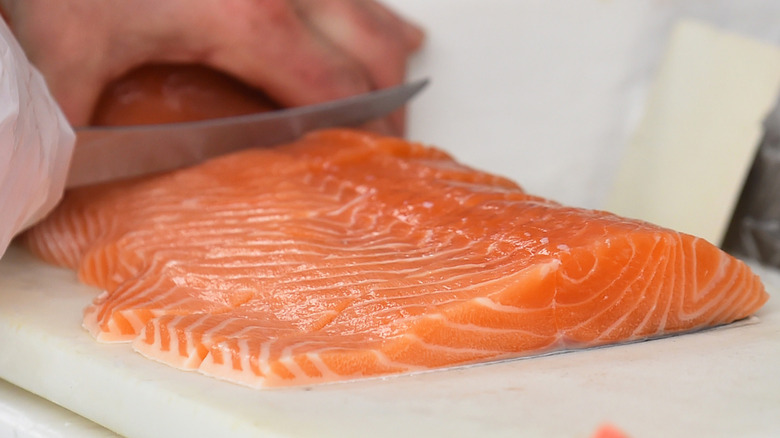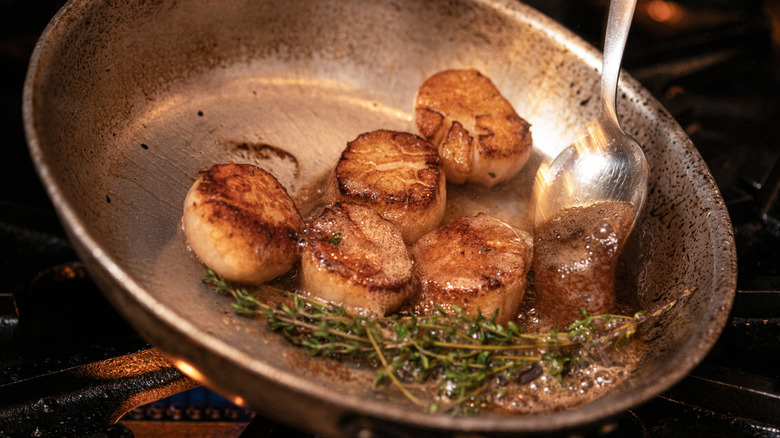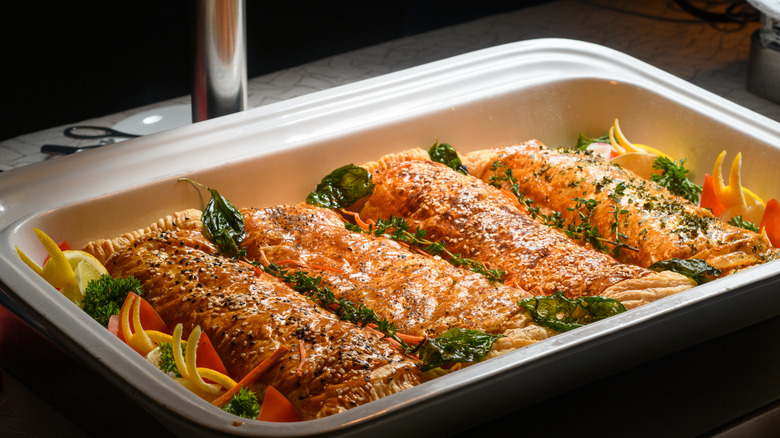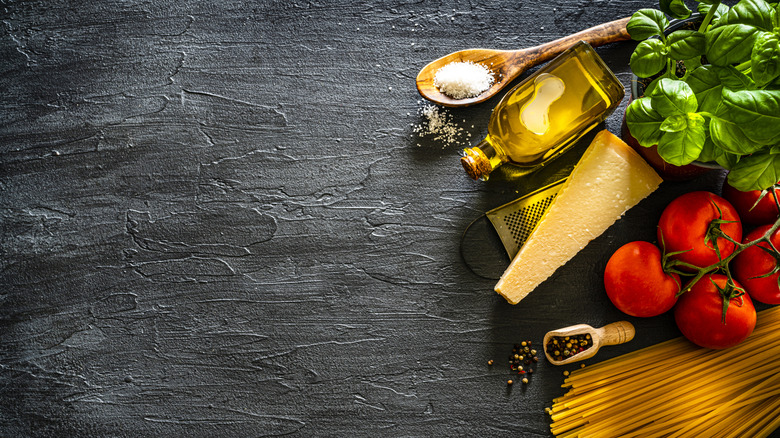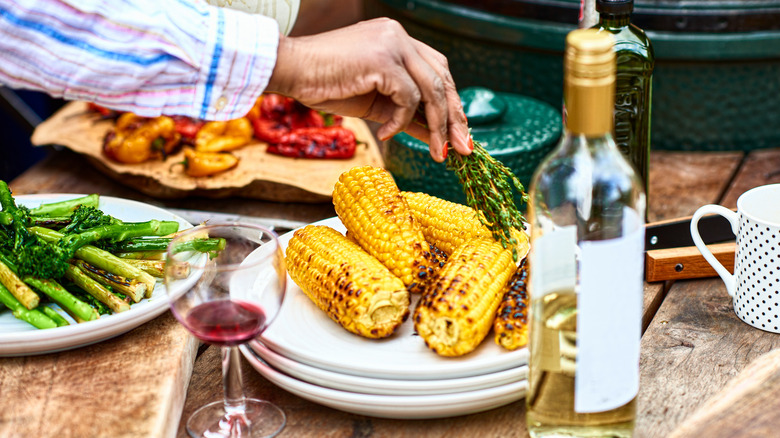Why Fish Tastes Better At Restaurants, According To Chefs
There's nothing like sitting down to dine at your favorite restaurant and indulging in your favorite dishes. While some people opt for a savory steak, creamy pasta, or decadent burger, many people opt to instead go for food they avoid cooking themselves at home like fish or shellfish. With countless varieties to choose from — like salmon, tilapia, mahi mahi, or lobster, just to name a few of the types of fish you should be eating — fish is a staple on restaurant menus across cuisines and price points thanks to its versatility and unbeatable flavor.
At any restaurant, when a fish dish comes to the table, it's usually cooked to perfection and topped with flavorful sauces or mouthwatering sides. But sometimes, recreating these memorable dishes feels all but impossible for home chefs. Try as they might, the fish they're cooking in the comfort of their own home just doesn't live up to its restaurant counterpart.
The reason why may be simple; whether they don't have the proper tools, techniques, or ingredients, there are several elements that go into creating a restaurant-quality fish dish. We talked to Moira Hill, executive chef at Ironside Fish & Oyster in San Diego to get the inside scoop on why fish always tastes better at restaurants — and how home chefs can recreate these delicious dishes the next time they have a seafood craving.
Using responsibly sourced or local fish
When it comes to flavorful fish, it's best to start with the basics. Imbuing your dish with flavor starts with sourcing sustainable fish from reputable fishermen and fishmongers. "If you don't know where your fish is coming from, you shouldn't purchase it," said chef Moira Hill. "[Restaurants use] good quality fish from local fishermen."
While restaurant chefs likely have reliable suppliers they trust, finding fresh and responsibly sourced fish can be trickier for home chefs looking to recreate their favorite meals at home. Consider three important questions when shopping for fish: What species is it? Where did it come from? How was it caught? Answers to these questions can help you determine whether the fish was sustainably raised or caught. You can also look for certain eco-labels on the packaging of frozen fish, like The Marine Stewardship Council's blue checkmark or the Aquaculture Stewardship Council's teal checkmark. When in doubt, ask the fishmonger at your local grocery store for advice. They're the experts on what's in season and what's freshest — which can help you get the most flavorful fillets.
Choosing high-quality ingredients
In addition to choosing sustainable fish, a restaurant often uses other high-quality ingredients to enhance the flavor of its dishes. While the fish may be the star of a particular meal, the accompanying ingredients are equally as important in highlighting the fish's flavor and rounding out the dish.
While in-season produce is a must for many chefs, in-season and locally sourced ingredients are even better. That's because items grown by local farmers or sourced from farmers' markets are often picked at peak ripeness (which also means peak flavor). Many chefs will even adjust their menus according to what's available — switching out sides or sauces to incorporate fresh produce instead of using something that's out of season. Seasonal menus can even help keep restaurant costs down, making it a win-win when it comes to both revenue and taste.
And it's not just the fresh ingredients that matter. High-quality, dried herbs and spices are also pivotal to the final flavor of a dish, both at restaurants and for home chefs. Although they typically come with a slightly higher price tag than their lower-quality counterparts, it's a worthwhile investment that pays dividends in terms of flavor. The end result is a fish dish that's so good, you want to eat it every day.
Storing fish properly, whether fresh or frozen
Restaurants are not only experts at how to prepare food, but also in how to store it safely. Different types of fish require different types of storage to keep it fresh and tasting its best. The type of storage depends on whether the fish is fresh, previously frozen, or currently frozen.
Fresh seafood needs to stay as cold as possible (without freezing), so it's vital to store it under a layer of ice in the refrigerator. Like other raw meat, it should also be kept separate from any other food (and even other fish) to prevent cross-contamination or exposure to bacteria. Fresh fish should be used within a day or two to catch it at its peak.
Frozen fish should remain in its packaging and be put into the freezer immediately. If possible, keep it in the back of the freezer with the door shut to keep it as cold as possible; maintaining the lowest possible temperatures will help keep the fish fresh for longer. When ready to use, defrosting the fish in the fridge for about 24 hours is the best method to maintain its moisture. Avoid thawing the fish at room temperature or in warm water, as this can negatively impact the texture. If you need your fish thawed fast, submerge it in cold water for 10 minutes at a time.
Serving unique varieties
When you sit down at a restaurant and start to peruse the menu, you'll likely see some common items in the seafood section: salmon, cod, and tuna are likely at the top of the list. And while there's nothing inherently wrong about these particular varieties, there are many more interesting options. "Salmon itself has been overplayed through the years; there are better choices out there," said chef Moira Hill.
To keep things exciting for diners (and especially the regulars), restaurants often experiment with new recipes and fish varieties. Instead of salmon, trout is a similar alternative that has a mild and nutty flavor. Though not as rich and fatty as salmon, it's flaky and delicious, making it an easy and logical swap for both restaurants and home chefs. Instead of cod, halibut and tilapia are both similar white fish that have mild flavors, perfect for pairing with intense sauces or vibrant herbs.
While these are simple swaps home chefs can implement when buying ingredients at almost any grocery store, there are also more unusual alternatives available. Shad is a large, oily fish similar to salmon; flounder is a mild flatfish similar to sole; and monkfish is a sweet fish that makes the perfect substitute for scallops. Though you may have to visit a speciality store for these varieties, it may prove to be worth it.
Not skipping tinned fish
When you envision ordering fish at a restaurant, you probably picture your plate coming to the table featuring a beautifully cooked fish fillet or deliciously decadent restaurant-quality fish sandwich. And while many restaurants offer several of these types of dishes on the menu, there's also another type of fish that's having a moment: tinned fish.
Though some may only think of tinned fish as classic anchovies or sardines, there's an entire, flavorful world of tinned fish out there — and restaurants are capitalizing on it. Seafood restaurant Saltie Girl in Boston and Los Angeles, for example, has an entire menu dedicated just to tinned fish. The menu features dozens of different tinned fish varieties from all over the world (though heavily concentrated in the Iberian peninsula) that are served with salt, butter, pickled peppers, jam, and French bread.
And while exotic imports from Portugal or Morocco may be over budget for home chefs, there are affordable alternatives readily available. Trader Joe's has several beloved varieties, including its canned smoked trout and sardines in olive oil with smoke flavor. Other, slightly more expensive options available at grocers like Whole Foods include Fishwife or Matiz. Just make sure to brush up on tips for tinned fish so you're maximizing both flavor and texture.
Properly prepping
Once restaurants have selected the fish to use for the menu, the real work begins. Properly preparing fish — especially a whole fish — is a time-consuming task that is pivotal to the final dish. "Butchering the fish, taking the bones out, drying or cutting the skin and scales, and portioning it out for service to the ounce you need to serve for the dish," are a must for prep, explained chef Moira Hill.
Whole fish must be gutted, have the head removed, be portioned into roughly 6 to 8-ounce fillets, and be descaled and deboned before the cooking can even begin. Fish that has already been filleted usually is already free of both bones and scales, but it still needs a little attention; it should be rinsed and patted dry to remove excess moisture before seasoning or cooking. Depending on the cooking method you choose, you can instead air-dry the fish in the refrigerator in advance to save time.
Choosing the right cooking method
The cooking method depends on the flavor and fat content of the fish being prepared. Professional chefs are well-versed in these techniques, making it easy for them to choose the best way to prepare their various dishes. And some cooking techniques are almost universal, bringing out the best in most fish varieties. "Frying or pan-frying is always great — also olive oil or butter poach[ing]," said chef Moira Hill. To pan-fry a fish fillet, first pat dry and season your fish. Then heat your preferred pan and add oil. Place the seasoned fillet into the pan, skin-side down to get a crispy, delicious crust. After a few minutes, flip the fish and cook for another couple of minutes until opaque.
"Every place cooks [fish] differently," Hill added. "You can poach, steam, or roast depending on the dish and the fish. A hard sear on a hot pan or plancha creates that crust and locks in the moisture." Grilling, cured or smoked, and even air-frying are all options as well. Some cooking methods, like en papillote (a French method of cooking fish in parchment packets), are easy and foolproof methods for home chefs. Just take a square of parchment paper and place your fish, seasoning, herbs, and any other ingredients (like onions, garlic, or lemon) in the center. Fold up the sides of the parchment and roll them together, creating a sealed pocket, and place it in the oven until the fish is cooked through.
Using the right cooking equipment
Half of the battle in preparing a delicious meal is having the right tools. Well-equipped restaurant kitchens have all the necessary gadgets, from staples like high-quality pans and knives to more niche items like mandolines and zesters.
While it might be intimidating to get started in your own kitchen without all of these bells and whistles, it's not required to make a memorable fish dish. For home chefs, "a good saute pan, some kosher salt, and olive oil" are the only real requirements, said chef Moira Hill.
Other tools that will make life easier for home chefs preparing fish include a sharp and high-quality chef's knife and a baking dish (for preparations in the oven like baking or roasting). A fish spatula — a tool designed specially to help move delicate fish — is also a nice-to-have. Those who already have the basics can expand their collection with more specific seafood tools like a fillet or boning knife, fishbone tweezers for removing bones, or a fish scaler.
Cooking fish to the perfect temperature
Cooking fish to the ideal level of doneness is an art that takes practice and skill. If you don't cook the fish enough, it can lead to foodborne illness at worst or an unpleasant texture and taste at a minimum. But if you cook it too much, the fish will become rubbery and unappetizing.
Though different fish varieties and size cuts require different cooking times, there are a few methods both professional and home chefs can utilize to achieve the perfect temperature. Celebrity chef Eric Ripert — known for his skill in fish cookery— recommends inserting a metal skewer into the fish and then holding it to your wrist to assess the fish's internal temperature. Another rule of thumb is to measure the fillet at its thickest point and cook for 10 minutes for every inch. Some fish and shellfish are a little easier to gauge; shrimp turns a translucent, light pink shade once it's cooked and shellfish like mussels and clams open their shells when ready. But when in doubt, simply use a meat thermometer to confirm the internal temperature of the fish is at least 140 degrees Fahrenheit.
Utilizing proven flavor pairings
"Fish is very versatile, depending on what fish you use. Think of towns and cultures near the sea like Greece, Italy, Spain. They all have different spices and flavors, but it's light enough to complement the seafood," said chef Moira Hill.
These Mediterranean countries often use signature ingredients like olive oil, lemon, olives, feta, and herbs to create a fresh, bright flavor profile. Other classic flavor combinations include warm Indian spices like turmeric and garam masala, or Caribbean flavors like blackening seasoning paired with the sweetness of fruit like mango or pineapple. Restaurants also often look to Asian flavors when preparing fish like soy sauce, ginger, rice wine vinegar, and black bean sauce. Southeast Asian flavors like curry, lime, chili, and cilantro also beautifully complement fish varieties like tilapia or cod or shellfish like mussels.
Home chefs looking to expand their repertoire can look to these regional cuisines for inspiration, and even recreate classic dishes. Even if the meal doesn't traditionally use fish as the main protein, it's usually easy to swap in for meat or poultry — especially when using white fish with mild natural flavor.
Not being afraid to experiment
While beloved flavor combinations are always a safe bet, you can also count on restaurant chefs to experiment with new, unusual, and interesting flavors in all of their dishes, including seafood. Though at first, some flavors may seem unexpected — or even unappealing — when paired together, these unique combinations can become a standout on restaurant menus. Combos like shellfish and mushrooms (think scallops with chanterelles or crab and portabellas) go well together thanks to the contrast of sweet and umami flavors — like a new interpretation of surf and turf.
Another approach is to combine classic flavors or recipes, but from multiple different cuisines. Mixing Mexican and Asian flavors, for example, may seem unusual at first. But salmon with spicy corn and mango salsa served over Asian coleslaw melds these summery flavors and ingredients in a delicious way. Restaurants think outside the box to come up with these unique flavor pairings, helping to set them apart — and home chefs can do the same. Experimenting and trial and error are simply the name of the game to find something you love.
Choosing the right sides
When preparing a fish at a restaurant, the chefs don't just think about the fish itself. They also consider what sides will round out the dish to make it as memorable as possible for diners. Because of the versatility of fish, you can pair it with almost any side. "Fish goes well with potatoes, starches, pastas, rice, broccolini, cauliflower, or carrots," explained chef Moira Hill.
Starches like potatoes, rice, or pasta like orzo can be infused with flavorful ingredients to complement the flavors used to cook the fish. For example, if your fish is prepared with Italian flavors like lemon, capers, and a white wine sauce, Parmesan-crusted baby potatoes would be a delicious side. For Asian-inspired recipes, rice absorbs excess sauce and complements the dish. But when in doubt, pick an in-season vegetable side and prepare it simply — like roasted in olive oil and with salt and pepper — or choose another easy side dish for those who hate cooking. You could even try an old-school side dish for a more creative take.
